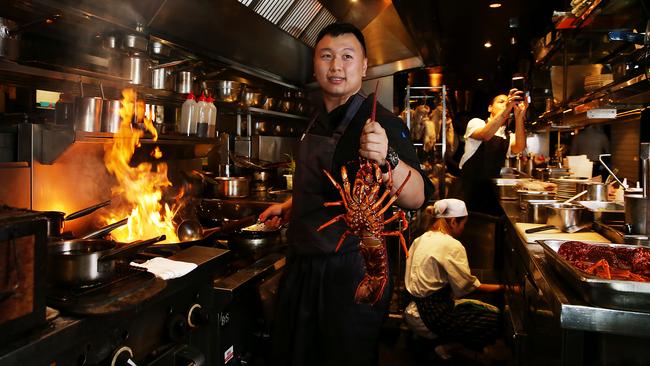Claws and effect: investors burnt on lobsters
A post-Christmas slump in lobster prices is threatening up to one-third of the jobs in the industry, with even the Lunar New Year celebrations unlikely to save the sector.

A post-Christmas slump in lobster prices is threatening up to one-third of the jobs in the industry, with even the Lunar New Year celebrations bump unlikely to save the sector.
Not a single lobster has been exported to China since November, and current local catch prices of $25/kg for southern rock lobster are not enough for many fishermen to break even.
Multiple industry sources said the break-even price was between $25 and $39/kg depending on size and location of the catch.
The Beijing-imposed restrictions on the once-lucrative lobster trade has sent the price of lobster harvest licences plummeting — not even the Tasmanian seafood business linked to Yuhu billionaire and alleged Chinese “agent of influence” Huang Xiangmo has been spared. For investors who bought in the boom years, including former South Australian senator Cory Bernardi, the capital losses will be devastating unless Xi Jinping’s administration and the Morrison government settle long-running differences.
The government made it clear in briefings it gave to the industry in January that it did not think that would happen in a hurry. Sources familiar with the briefings told The Australian that the Department of Foreign Affairs said Beijing wanted to hear Australian businesses squirm.
Industry sources said more than a third of the lobster economy’s thousands of jobs in fishing towns around the country could go within months.
“We’re a resilient bunch ... but, absolutely, it’s going to be tough,” said Michael Blake, managing director of the Australian Southern Rock Lobster Exporters Association, from Tasmania.
No other industry caught up in China’s sweeping trade campaign on more than $20bn of annual Australian exports is as vulnerable as the lobster sector.
After Beijing imposed an 80 per cent tariff in May, barley farmers found other markets in the Middle East, even if they didn’t pay quite as much.
Blacklisted Australian coal has been redirected to India and other markets at a price that is lower but far from debilitating.
Lobsters are different.
Southern rock lobsters from Tasmania, South Australia, Victoria and New Zealand are premium products in the world’s ritziest live seafood market.
The next best customers won’t pay half as much as the banqueters in mainland China.
While lobster fishermen feel the pinch, another industry is benefiting from the low prices — Australian diners.
“We’re serving lobster at prices not seen for 20 years,” said Dan Hong, the executive chef at Sydney restaurant Mr Wong.
The Cantonese-style restaurant — part of the Merivale entertainment empire — has recently been selling southern rock lobster for $219/kg, an $80 fall from before the bubble burst.
“It is a fantastic opportunity to not only support your local restaurants, but also the fishers whose livelihoods are depending on the domestic industry,” Mr Hong said on Sunday.
Peter Creighton, one of the owners of NZ Red — a lobster export business based in Auckland — said if New Zealand was shut out of China, more than half of the country’s $300m annual lobster export would be wiped out.
“The Australians are selling into the likes of Taiwan and Japan at the moment. That’s at hugely discounted prices,” he said.
Mr Creighton, who has 30 years’ experience in the industry, says the risk of losing half the annual lobster export market is why almost 100 per cent of NZ Red’s catch is sent by air freight to the world’s second-biggest economy.
It’s a similar story across the New Zealand industry and, until three months ago, over the ditch.
“It’s just a real tragedy for Australia,” Mr Creighton said.
Last January, the New Zealand industry was in freefall as the coronavirus outbreak shut down the crucial Chinese market.
Now with the Australian’s supply shut out, the Kiwis are selling their prized red catch for more than $120/kg, a hugely profitable price that could rise higher.
Fishermen from the US, whose products are considered a poorer one to those caught in Australia and New Zealand, are also benefiting from the vacated tank space, as are their peers around the world.
If prices stay at their current level, hundreds perhaps thousands of jobs will go after the JobKeeper subsidy expires in March.
At $25/kg for southern rock lobster — about one-third of the price they fetched before the Chinese export ban — most cannot cover the cost of diesel, crew, boat upkeep and fees to government for fishing rights.
It is an alarming situation days out from Lunar New Year, which is for Australian lobster fisherman what Thanksgiving is for American turkey farmers.
If the market won’t support fishermen to head to sea, they will sell less lobsters to the wholesalers. That reduced catch will mean less jobs for the outfits that do the processing and export work for about $15-$25/kg of lobster.
And it means that holders of licences for what until three months ago was the world’s most lucrative lobster quota — including a Tasmanian investor who industry sources said is now $5m in debt after paying close to $10m for licences in late 2019 — will struggle to find fisherman who will pay for the rights to catch their suddenly cut-priced product.
Mr Blake, the Tasmanian lobster exporter, said licences to catch southern rock lobsters were selling for more than $90,000 a pot in late 2019, when neither the ban nor the coronavirus had appeared.
Even at that elevated price, holders were making a return of about $5500 a year per pot selling their rights to fishermen.
“Right now, your $90,000 investment is returning you nothing,” Mr Blake said.
The industry’s huge exposure to the Chinese market — a consequence of the massive premium Chinese consumers will pay for Australia’s lobsters — made them a big target. Without access to China, their fat years are over.
Many of the most exposed electorates are held by Coalition MPs, including new Trade Minister Dan Tehan, who holds the Victorian seat of Wannon.
If new markets can be found and domestic consumption increased, a return to sustainability is possible. Mr Blake says if the price fishermen get paid increases by $10-$15/kg, jobs losses could be avoided in regional electorates around the country.








To join the conversation, please log in. Don't have an account? Register
Join the conversation, you are commenting as Logout